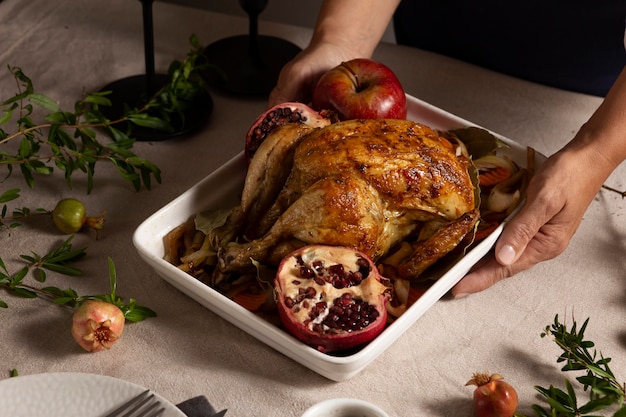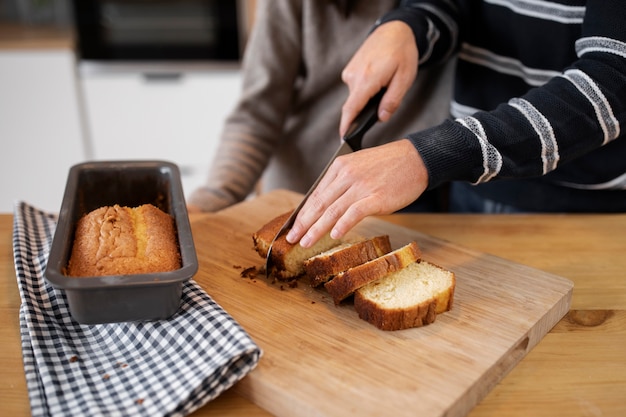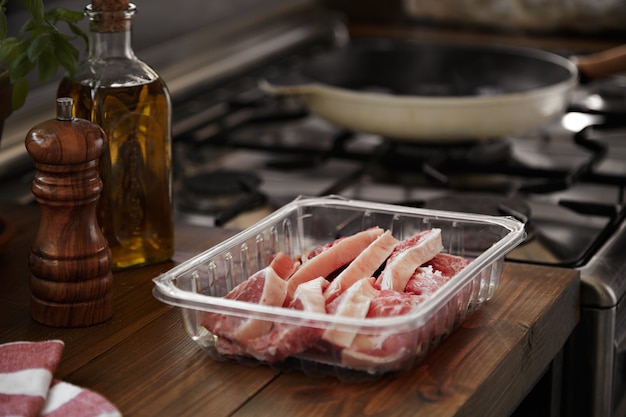There’s a certain satisfaction that comes with holding a beautiful piece of tenderloin, its marbling glistening under the lights. You can almost taste the succulent, juicy meat, the perfect balance of tender and flavorful. But, before you whisk it away to the oven, there's a little knowledge we need to sort out. cooking tenderloin is more than just tossing it in the heat and hoping for the best. It's a bit of a dance, you know, getting the timing just right. Too long in the oven, and you end up with a dry, disappointing mess. Too short, and well, let's just say it wouldn't be a delicious experience. So, let's dive in and learn how to nail that perfect tenderloin roast, shall we?
Part 1: Picking the Perfect Piece

Let's start with the most crucial step: choosing the right tenderloin. I've been around the block a bit, seen my fair share of tenderloins, and trust me, they're not all created equal. You want a piece that's got a good, even thickness, no weird lumps or bumps, and a nice, deep red colour. The fat marbling is also important – it’s the key to juicy, flavorful meat. Think of it like the secret ingredient to a succulent roast.
1.1: Size Matters
The size of your tenderloin will determine how long it takes to cook. A small tenderloin, say around 1-1.5 pounds, will be ready quicker than a big one that's pushing 3 pounds or more. For a smaller tenderloin, you might be looking at a 20-30 minute cook time, while a larger one could take up to 50-60 minutes.
1.2: Don't Be Afraid to Ask
If you're at the butcher's, don't be shy. Ask for a bit of advice! A good butcher will know their stuff, they'll be able to point you towards the perfect cut and give you some tips on how to cook it. They might even have some insider tips on how to get that perfectly tender, flavorful result you're aiming for.
Part 2: The Prep Work: It’s All About The Details

Now, you've got your prime piece of tenderloin, it's time to get down to the prep work. This bit is all about setting the scene for a beautiful, flavourful roast. Think of it as getting the stage ready for the star of the show.
2.1: Seasoning Like a Pro
Okay, this is where the fun really starts. Salt and pepper are your basic seasonings, but you can get creative with herbs and spices, too. I'm a big fan of rosemary, thyme, and garlic. They add a beautiful earthy aroma and complement the rich flavor of the tenderloin. You can rub them directly onto the tenderloin, or mix them with a bit of olive oil and make a paste. A little bit of mustard, especially Dijon, can also add a lovely touch of tanginess, adding a bit of complexity to the flavor profile.
2.2: Don't Forget the Fat
Remember those fat marbling bits we talked about earlier? Well, they're not just for looks, they actually help to add flavor and keep the tenderloin juicy. Now, if you've got a piece that's looking a bit lean, don't fret! You can easily add some extra fat. Simply rub a little bit of butter or olive oil over the surface. This will help to create a lovely crust and keep the meat from drying out.
2.3: Pat It Dry
Before you pop that tenderloin into the oven, pat it dry with paper towels. This will help the seasoning adhere better and prevent excess moisture from steam building up in the oven. It's a simple step that can make a big difference in the final result.
Part 3: Getting Ready to Roast

Alright, the stage is set, the tenderloin is prepped, now it's time to get ready for the main event. This is where the oven comes in. Before we get into the cooking times, let's talk about the right temperature.
3.1: The Ideal Oven Temperature
For a tenderloin, the perfect oven temperature is around 400°F (200°C). This temperature gives you a nice, even cook, and it helps to keep the meat moist.
3.2: The Right Pan
Now, you'll want to choose a roasting pan that's big enough to hold your tenderloin without it being squished. A sturdy roasting pan is best, preferably one with a rack to elevate the tenderloin and allow for even air circulation. And don't forget to add a little bit of water to the bottom of the pan, it helps to create steam and keep the meat from drying out. You can also use a little bit of wine or stock for added flavor.
Part 4: Cooking Time: A Detailed Guide
Alright, let's get to the nitty-gritty, the bit you've been waiting for, the cooking time! This is where it's important to take the size of your tenderloin into consideration. The table below gives you a pretty good idea of how long it's going to take, but remember, this is just a guideline.
4.1: Tenderloin Cooking Times
Here's a table that lays out the estimated cooking time for different sizes of tenderloin:
| Tenderloin Weight (lbs) | Cooking Time (Minutes) | internal temperature (°F) |
|---|---|---|
| 1-1.5 | 20-30 | 145 |
| 1.5-2 | 30-40 | 145 |
| 2-3 | 40-50 | 145 |
| 3 | 50-60 | 145 |
These are just estimates, and the actual cooking time will depend on factors like the thickness of the tenderloin, your oven's temperature, and even the altitude.
4.2: The Importance of the Internal Temperature
This is probably the most important part of cooking tenderloin. You don't want to overcook it, so using a meat thermometer is essential. You want the internal temperature to reach 145°F (63°C) for medium-rare. Remember, it's better to err on the side of undercooked than overcooked. The meat will continue to cook slightly as it rests, so you don't need to worry about it being too pink. If you want your tenderloin well-done, you'll need to cook it to an internal temperature of 160°F (71°C).
4.3: Let It Rest
Once your tenderloin is cooked, resist the urge to carve it straight away. It needs a little bit of time to rest. This allows the juices to redistribute, making for a more tender and juicy roast. Cover the tenderloin with tin foil and let it rest for about 10-15 minutes. While it's resting, you can make a simple sauce with the pan juices. Just deglaze the pan with a little bit of wine or stock and whisk in some butter.
Part 5: The Finishing Touches
The tenderloin is cooked, it's rested, now it's time to give it the finishing touches. This is where you get to really bring out the flavours and make it your own.
5.1: Carving Like a Pro
Okay, this is a bit of an art form. The key is to make nice, even slices. The best way is to use a sharp carving knife and cut across the grain. If you're unsure about the grain, just look for the direction the muscle fibres are running.
5.2: Don't Forget the Sauce!
The pan juices from the roasting are pure gold, they add an incredible depth of flavour to your tenderloin. Now, you can just spoon them over the meat as is, but I prefer to make a simple sauce. A little bit of wine, some stock, and a touch of butter will do the trick. You can also add some herbs, like rosemary or thyme, to enhance the flavour further.
5.3: Presentation Matters
You've gone through all this effort, so don't let the presentation be an afterthought. A beautifully carved tenderloin, arranged on a platter and drizzled with a rich, flavorful sauce, is a true culinary masterpiece. You can add a few sprigs of rosemary or thyme for a touch of greenery.
Part 6: Serving Up a Feast
So, the tenderloin is carved, the sauce is made, it's time to serve up a feast! A plate piled high with tender, juicy tenderloin, drizzled with a rich, flavourful sauce, it's a sight to behold, isn't it? You can serve it with all sorts of sides, roasted vegetables, mashed potatoes, or a salad. Whatever your heart desires!
Part 7: Leftovers? No Problem!
Got leftovers? Don't you worry, you can easily transform them into a whole new dish. Slice the tenderloin and make sandwiches. You can also add it to salads, or even make a delicious soup. There's no need to let those precious leftovers go to waste!
Part 8: FAQs: Tenderloin Cooking Time: Perfect Oven Roasting Guide
8.1: What if my tenderloin is too thick?
If your tenderloin is too thick, you can always tie it up with kitchen twine. This helps to ensure that it cooks evenly. You can also slice it in half to make it thinner. If you choose to slice it, make sure to cook the pieces separately, as they will cook at different rates.
8.2: Can I use a meat thermometer?
Absolutely! A meat thermometer is a great way to make sure your tenderloin is cooked to your liking. Insert the thermometer into the thickest part of the meat to get an accurate reading.
8.3: What happens if I overcook the tenderloin?
If you overcook your tenderloin, it will become dry and tough. You won't be able to salvage it completely, but you can try to add some moisture back by making a sauce with the pan juices.
8.4: Is it okay to cook a tenderloin on the bone?
You can cook a tenderloin on the bone, but it will take longer to cook. Make sure to adjust your cooking time accordingly. You'll also want to use a higher oven temperature to ensure that the bone gets cooked properly.
8.5: What are some other ways to cook tenderloin?
You can also cook tenderloin in a slow cooker, on the grill, or even pan-fry it. Each method has its own unique flavour and texture. For example, slow-cooking tenderloin will result in incredibly tender, melt-in-your-mouth meat, while grilling it will give you a crispy exterior and a juicy interior.
Alright, that's it for today. Hopefully, this guide has given you a good understanding of how to cook tenderloin. Remember, it's all about choosing the right piece, prepping it properly, and understanding the cooking times. With a little bit of practice, you'll be a tenderloin-roasting pro in no time!
Everyone is watching

Corn on the Cob: The Ultimate Guide to Perfectly Cooked Ears
Healthy MealsAh, corn on the cob. Just the name evokes images of sunny days, barbecues, and that sweet, juicy flavour that ...

Scallops: The Ultimate Guide to Perfect Cooking
Healthy MealsAh, scallops. Those delicate, sweet, and utterly delicious morsels of the sea. They hold a special place in my...

Spaghetti Squash: The Ultimate Guide to Cooking and Serving
Healthy MealsRemember that time you saw spaghetti squash at the supermarket, looking all bumpy and strange, and thought, "W...

Salmon Cooking Times: Perfect Guide for Every Recipe
Healthy MealsLet me tell you, cooking salmon is an art form. It's all about getting that perfect balance: juicy and tender,...

Ham Cooking Time: How Long to Bake, Smoke, or Boil a Delicious Ham
Healthy MealsAh, ham. It's a classic, isn't it? A real crowd-pleaser, especially around holidays. And when done right, it'...
